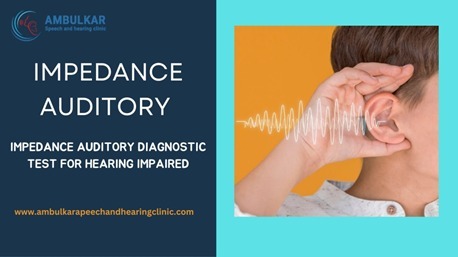 Call Us
Call Us
 Mail Us
Mail Us

An ear, nose, and throat (ENT) doctor performs an impedance analysis to determine if there are any underlying issues with your hearing system, particularly with your eardrum.
Auditory function tests typically fall into one of two categories: subjective and objective. Subjective tests, such as the classic tonal test and vocal audiometric test, involve the person performing the test actively. For example, they may have to raise their hand or push a button when hearing a sound sent through a set of headphones inside a booth. Or they may have to repeat a set of words sent in headphones and out of them (speech audiometry) in headphones and in a free field.
Objective tests do not involve the person being tested actively and are required for the completion of the results of the subjective tests as well as for testing the hearing of the non-compliant (i.e., children under the age of 4) and for obtaining accurate information on the functional status of the mid and inner ear as well as on the central acoustical pathways. Impedance Auditory some of the objective tests that need to be included in the scope of study include impedance measurements, electroencephalogram (EEG), evoked potential (evoked potentials) and acoustic Otoemissions.
Impedance Audiometry is a non-intrusive, objective audiometry test that provides information about
Usually, impedance audiometry is done after a specialist visit and an audiometric examination, at any public or private otorhinolaryngological office or clinic. Impedance auditory Once the doctor has determined that the canal of the ear is clear of secretions (or earwax), he inserts a small, rubber-terminated probe into the canal. The pressure applied by the probe results in a series of tracer traces, which can be seen on the impedancemeter. These tracer traces provide, in turn, information about the state of the ear drum and the middle ear (the tympanogram), as well as whether or not there are stapedial (or other) reflexes.
Impairment audiometry measures how well the structures in the middle ear (the tympanic membrane, ossicular chain, etc.) respond to mechanical vibrations (sound waves) transmitted from the air to the fluids in the cchlea. As a result, impedance audiometry provides specific information about the functioning of the mid-eardrum-osnodular system. Tympanometry is an easy-to-implement, non-invasive test used to detect hearing issues caused by middle ear disorders (e.g., catarrhals, obits media, and tympanosclerosis and otosclerosis). Typically, impedance measurements are broken down into tympanometrics and stapedial reflex studies.
Tympanometry involves inserting a soft rubber pad-equipped probe into the external auditory canal to create a perfect seal. A bell-shaped curve, known as a tympanogram, is obtained. The tympanogram represents the exact value of pressure in the middle ear, and the graphic representation of this curve provides the specialist with valuable information about the condition of the mid ear. The resulting curves are usually:
Type D and E curves, which are much less common, are always a sign of mid ear pathology. Tympanometry can also help us understand the function of Eustachian tubes. The stapedial reflex can also be used to identify some of the pathological conditions that affect the mid ear (e.g. otosclerosis).
In children, basic information on whether or not inflammation of your middle ear is present is provided by the impedance test and in particular, by your tympanogram. Otitis media can be classified as catarrhal or purulent and may be characterized by a more or less extensive mucous exudate, serous exudate or pelleted exudate that partly or completely covers the middle ear.
In children, basic information on whether or not inflammation of your middle ear is present is provided by the impedance test and in particular, by your tympanogram. Otitis media can be classified as catarrhal or purulent and may be characterized by a more or less extensive mucous exudate, serous exudate or pelleted exudate that partly or completely covers the middle ear.
The impedance auditory diagnostic test is one of the most important tools in the evaluation of people with hearing loss. By carefully studying the middle ear’s impedance characteristics, this test provides clinicians with important information about the health and functioning of the entire auditory system. By testing tympanometrics and acoustic reflexes, it is possible to identify abnormalities such as fluid build-up, ear canal perforation, and otolaryngoid chain dysfunction, which are all major causes of hearing loss. The information gathered from this diagnostic method allows healthcare professionals to make accurate diagnoses and develop personalized intervention strategies to meet the specific needs of each individual patient. As research and technology advances, the impedance auditory diagnosis test promises to become an increasingly important tool in the treatment of hearing impairment, ultimately improving the quality of
"Unlocking Hearing Potential: Discover Clarity with our Impedance Auditory Diagnostic Test for the Hearing Impaired. Feel free to contact us at Ambulkar speech and hearing clinic for personalized care and expert guidance."